Unit 6When was it invented SectionA 3a-3c 课件(共34张PPT) 人教版英语九年级全册
文档属性
| 名称 | Unit 6When was it invented SectionA 3a-3c 课件(共34张PPT) 人教版英语九年级全册 |  | |
| 格式 | pptx | ||
| 文件大小 | 18.3MB | ||
| 资源类型 | 教案 | ||
| 版本资源 | 人教新目标(Go for it)版 | ||
| 科目 | 英语 | ||
| 更新时间 | 2024-10-01 10:06:49 | ||
图片预览

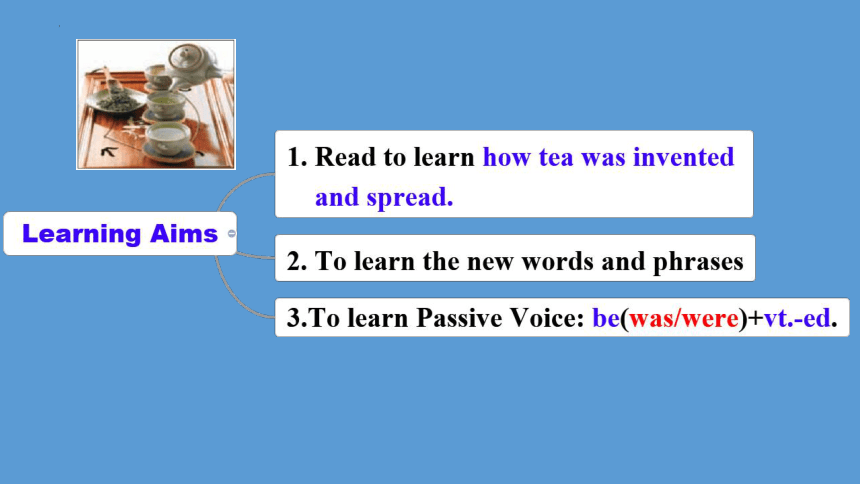

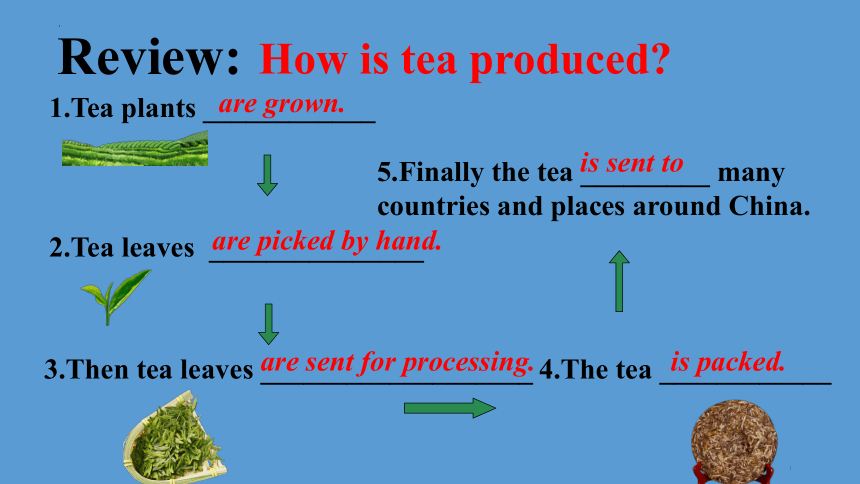
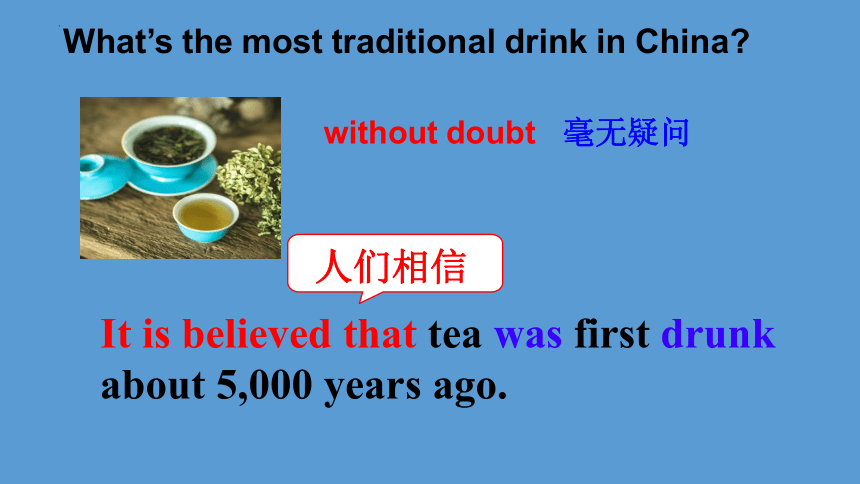
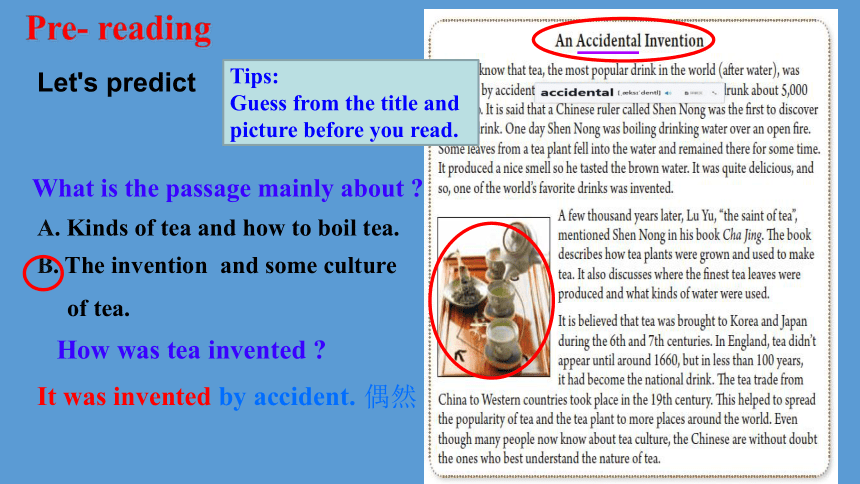
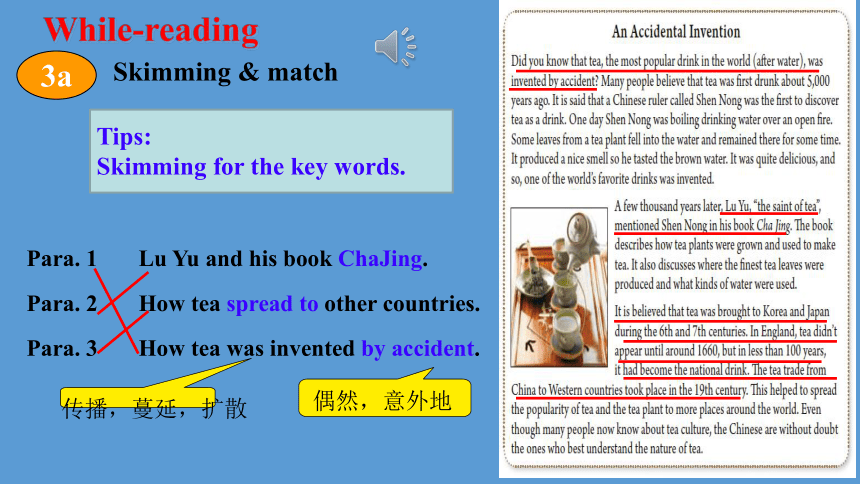
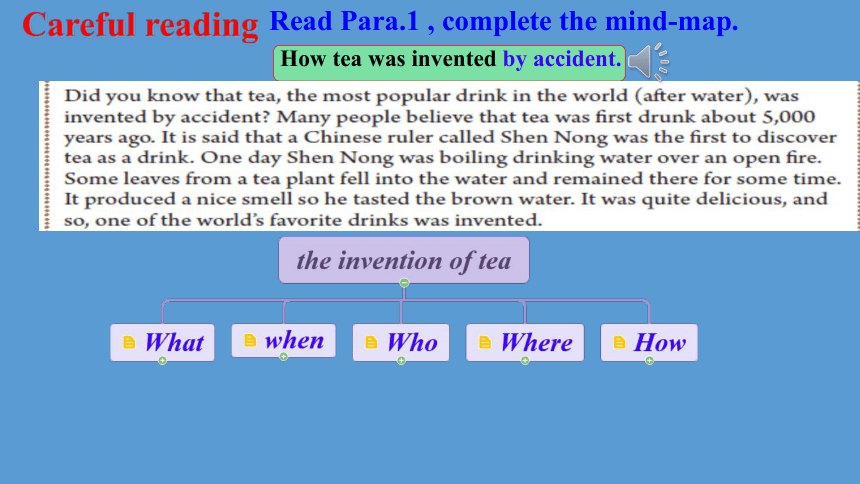
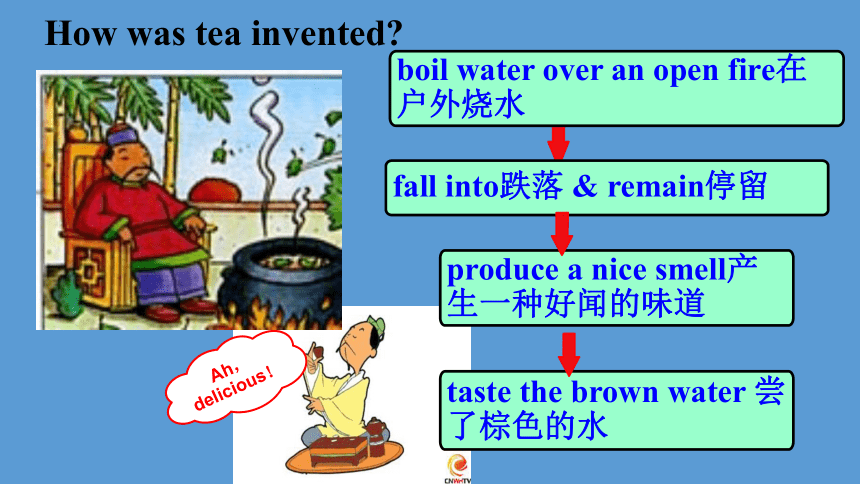
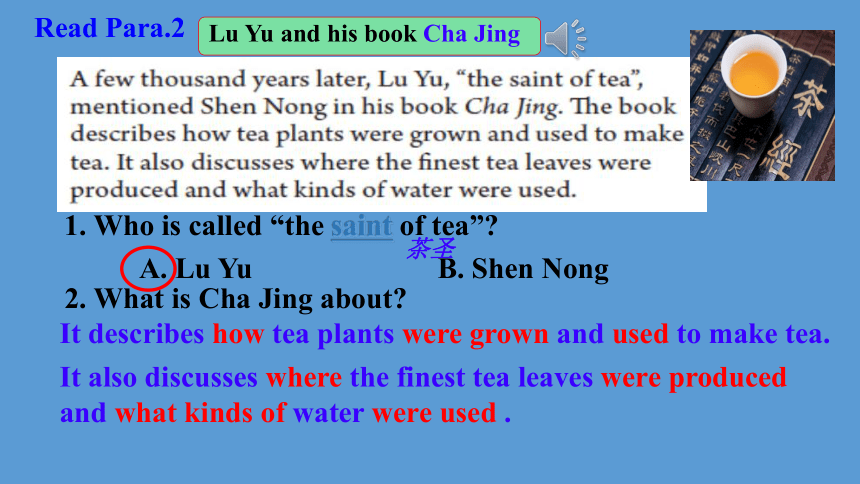


文档简介
(共34张PPT)
Unit 6
When was it invented
accidental
ruler
boil
remain
smell
saint
national
trade
popularity
by accident
take place
without doubt
Words Review
How is tea produced
1.Tea plants ____________
2.Tea leaves _______________
3.Then tea leaves ___________________
4.The tea ____________
5.Finally the tea _________ many countries and places around China.
are grown.
are picked by hand.
are sent for processing.
is packed.
is sent to
Review:
What’s the most traditional drink in China
It is believed that tea was first drunk about 5,000 years ago.
人们相信
without doubt 毫无疑问
Pre- reading
Let's predict
Tips:
Guess from the title and picture before you read.
B. The invention and some culture
of tea.
What is the passage mainly about
A. Kinds of tea and how to boil tea.
How was tea invented
It was invented by accident.
偶然
While-reading
Skimming & match
Tips:
Skimming for the key words.
Para. 1 Lu Yu and his book ChaJing.
Para. 2 How tea spread to other countries.
Para. 3 How tea was invented by accident.
传播,蔓延,扩散
偶然,意外地
3a
Careful reading
Read Para.1 , complete the mind-map.
How tea was invented by accident.
fall into跌落 & remain停留
boil water over an open fire在户外烧水
taste the brown water 尝了棕色的水
produce a nice smell产生一种好闻的味道
Ah,
delicious!
How was tea invented
Read Para.2
Lu Yu and his book Cha Jing
1. Who is called “the saint of tea”
A. Lu Yu B. Shen Nong
茶圣
2. What is Cha Jing about
It describes how tea plants were grown and used to make tea.
It also discusses where the finest tea leaves were produced and what kinds of water were used .
How tea spread to other countries
Read Para. 3 and complete the sentences.
1. Tea was brought to Korea and Japan during ___________________.
2. In England, tea didn’t appear until around _____________________.
3. The tea trade from China to Western countries took place in the ____________.
the 6th and 7th centuries
1660
19th century
Complete the sentences with the correct forms of the verbs in the box.
invent drink bring produce trade
1.One of the world’s favorite drinks was _________ by accident.
2.Tea was first ________ by Shen Nong about 5,000 years ago.
3.A nice smell was _________ when the tea leaves dropped into the hot water.
4.Tea was _________ to Korea and Japan during the 6th and 7th centuries.
5.Tea is now _________ between many different countries.
invented
drunk
Post-reading
produced
brought
traded
3c
Post-reading
5,000 years ago
during the 6th and 7th centuries
Tea was brought to
Korea and Japan .
around 1660
around the 8th century
(a few thousand years later)
Lu Yu, “the saint of tea”,
wrote a book about tea.
Tea appeared in England.
in the 19th century
The tea trade from
China to Western
countries took place
Tea was invented by accident.
Development In China
In China, tea is no longer a
kind of drink, but it gradually
became a kind of culture
and art.
The Chinese are without doubt
the ones who best understand
the nature of tea.
Overseas Development
Tea was not only popular in China, but also popular all over the world .
The history of tea
An accidental invention
Para.1
___ was invented by ____ ____5,000 years ago.While he was ______ drinking water,
some leaves _______the water and _______
there for some time. It tasted nice.
Para.2
_____ wrote Cha Jing. It described how tea was _______and ________.
Para.3
Tea was brought to______and _____ during the 6th and 7th centuries. Appeared in _______ around 1660. The tea trade took place ________________.
Tea
Shen Nong
boiling
remained
Lu Yu
grown
produced
Korea
Japan
England
in the 19th century
Post-reading
fell into
Retell the story of tea
Language Points
Did you know that tea, the most popular drink in the world (after water), was invented by accident
你知道茶,这种世界上最受欢迎的饮料(仅次于水),是偶然被发明的吗?
1)本句是一个复合句。主句是Did you know, that引导的是一个宾语从句,其中从句的主语是tea, 而the most popular drink in the world (after water), 是tea的同位语。
2) by accident 偶然;意外地
这是一个介词短语,在句中作状语,等于 by chance
我偶然知道了他的名字。
I knew his name by accident.
2. It is said that a Chinese ruler called Shen Nong first discovered tea as a drink.
据说有一位叫神农的中国统治者最早发现了茶可以饮用。
ruler 名词 统治者;支配者
It is said that… 据说……,其中It 是形式主语,真正的主语是that引导的整句。
据说他每天都要工作16个小时。
It is said that he works 16 hours every day.
It is believed that tea was brought to Korea and Japan during the 6th and 7th centuries.
人们认为,茶在6至7世纪传到了朝鲜和日本。
It is believed that… 人们认为/据信……
其中It 是形式主语,真正的主语是that引导的整句。
类似句型
“It is ... that” 句式
It is reported that … 据报道……
It is known that… 众所周知……
It is supposed-that… 据推测……
It is reported that many people work at home.
据报道,许多人在家工作.
3. Some leaves from a tea plant fell into the water and remained there for some time.
一株茶树上的几片叶子落到水里并停留了了一段时间。
fall相关的其他短语:
(l) fall into 落人;掉入
他喝醉了,跌落到水中。
He was drunk and fell into the water.
fall asleep 入睡 fall down 倒下;落下
fall in love with 与......相爱 fall over 被......绰倒
fall off 跌落;从......掉下来
fall - fell - fallen
你要在此地停留多久?
How long will you remain here
remain 作连系动词,表示“仍然是(处于某种状态);保持不变”,相当于keep。其后可接形容词、名词、分词或介词短语作表语。
尽管处于危险中,但他依然镇定。
He is in danger, but he remains calm.
Peter became a manager, but Jack remained a worker.
彼得成了 一名经理,而杰克仍然是个工人。
当我进来时,她仍然坐着。
(2)remain (to stay in the same place)
此处用作不 及物动词,意为“停留;逗留”。
She remained sitting when I came in.
(1) smell可作不可数名词,也可作可数名词,意为
“气味”。用作可数名词时,表示“某 一种气味”。
This flower hasn’t much smell.
这种花的香味儿不浓。
There’s a smell of cooking.
有股烧菜做饭的味儿。
4. It produced a nice smell so he tasted the brown water.
水里散发出一种怡人的气味,因此他 品尝了这种棕色的水。
(3)smell用作连系动词,意为“闻起: 后跟形容 词 作表语。
These flowers smell very sweet.
这些花闻起来很香。
feel, look, sound, smell, taste被称为感官动词,均可作连系动词,后面接形容词作表语。
The cloth feels very soft.
这块布料摸起来很柔软。
(2)smell还可用作及物动词,意为“闻到;发出 ……气味”,其后可接名词或代词。
I don’t smell anything.
我什么也闻不到。
The British national flag is red, white and blue.
英国国旗是红、白、蓝三色。
Our newspaper is a national newspaper.
我们的报纸是全国性的报纸。
5. …it had become the national drink.
……它已经变成了全国性的饮料。
national 形容词 国家的;全国的
nation 名词 国家
nationality 国籍
Great changes have taken place since 1976.
自1976年以来发生了巨大的变化
6. The tea trade from China to Western countries took place
in the 19th century.
中国和西方国家之间的茶叶贸易发生在19 世纪。
take place 常指有计划的“发生;出现”,不及物动词短语 ,不能接宾语,一般也不用作被动结构。
take place 表示必然性的“发生”或 指根据计划或安排“举行”的. 无被动语态
happen 表示偶然性的没预料到的 “发生”,无被动语态
take place 与 happen
辨析:
The opening of the play will take place tomorrow night .
这部剧将于明晚进行首演。
The car accident happened last week
这起车祸发生在上周。
7. Even though many people now know about tea culture, the Chinese are without doubt the ones who best understand the nature of tea.
尽管现在许多人了解茶文化,但是中国人无疑是最懂茶的内涵的人。
(1)这是一个多重复合句。even though引导让步状语从句。
主句中含有一个定语从句 who best understand the nature of tea,修饰前面的先行词ones。
If there is any doubt, you had better make certain.
如果有什么疑问,你最好弄清楚。
Without doubt , she has been working hard.
她的确一直在努力工作。
(2) doubt (a feeling of being uncertain about sth.)
名词,意为“疑惑;疑问”,
without doubt 意为 “毫无疑问;的确”
doubt作动词,意为“怀疑;不相信”,其后 可直接跟名词或代词作宾语。
I have no reason to doubt him.
我没有理由怀疑他。
无论doubt用作名词还是动词,在肯定句中其后常接whether从句,在否定句和疑问句中常接that从句。
We doubt whether he will come.
我们怀疑他是否会来。
There is no doubt that our experiment will
succeed.
毫无疑问我们的实验会成功。
In history, there are many inventions invented by accident .
Chance is the best inventor. The little problem that we meet in our daily lives, maybe inspiration for great inventions.
Observe and think more!
多观察,勤思考!
Summary
1. Recite the passage after school.
2. Make sentences with these words:
by accident, it is believed that, take place, without doubt, remain,smell,not...until..., fall into...
Did you know that tea, the most popular drink in the world (after water), was invented by accident Many people believe that tea was first drunk about 5,000 years ago. It is said that a Chinese ruler called Shen Nong was the first to discover tea as a drink . One day ShenNong was boiling drinking water over an open fire. Some leaves from a tea plant fell into the water and remained there for some time. It produced a nice smell so he tasted the brown water. It was quite delicious, and so, one of the world’s favorite drinks was invented.
A few thousand years later, Lu Yu, “the saint of tea”, mentioned Shen Nong in his book Cha Jing. The book describes how tea plants were grown and used to make tea. It also discusses where the finest tea leaves were produced and what kinds of water were used.
It is believed that tea was brought to Korea and Japan during the 6th and 7th centuries. In England, tea didn’t appear until around 1660, but less than 100 years, it had become the national drink. The tea trade from China to Western countries took place in the 19th century. This helped to spread the popularity of tea and the tea plant to more places around the world. Even though many people now know about tea culture, the Chinese are without doubt the ones who best understand the nature of tea.
Unit 6
When was it invented
accidental
ruler
boil
remain
smell
saint
national
trade
popularity
by accident
take place
without doubt
Words Review
How is tea produced
1.Tea plants ____________
2.Tea leaves _______________
3.Then tea leaves ___________________
4.The tea ____________
5.Finally the tea _________ many countries and places around China.
are grown.
are picked by hand.
are sent for processing.
is packed.
is sent to
Review:
What’s the most traditional drink in China
It is believed that tea was first drunk about 5,000 years ago.
人们相信
without doubt 毫无疑问
Pre- reading
Let's predict
Tips:
Guess from the title and picture before you read.
B. The invention and some culture
of tea.
What is the passage mainly about
A. Kinds of tea and how to boil tea.
How was tea invented
It was invented by accident.
偶然
While-reading
Skimming & match
Tips:
Skimming for the key words.
Para. 1 Lu Yu and his book ChaJing.
Para. 2 How tea spread to other countries.
Para. 3 How tea was invented by accident.
传播,蔓延,扩散
偶然,意外地
3a
Careful reading
Read Para.1 , complete the mind-map.
How tea was invented by accident.
fall into跌落 & remain停留
boil water over an open fire在户外烧水
taste the brown water 尝了棕色的水
produce a nice smell产生一种好闻的味道
Ah,
delicious!
How was tea invented
Read Para.2
Lu Yu and his book Cha Jing
1. Who is called “the saint of tea”
A. Lu Yu B. Shen Nong
茶圣
2. What is Cha Jing about
It describes how tea plants were grown and used to make tea.
It also discusses where the finest tea leaves were produced and what kinds of water were used .
How tea spread to other countries
Read Para. 3 and complete the sentences.
1. Tea was brought to Korea and Japan during ___________________.
2. In England, tea didn’t appear until around _____________________.
3. The tea trade from China to Western countries took place in the ____________.
the 6th and 7th centuries
1660
19th century
Complete the sentences with the correct forms of the verbs in the box.
invent drink bring produce trade
1.One of the world’s favorite drinks was _________ by accident.
2.Tea was first ________ by Shen Nong about 5,000 years ago.
3.A nice smell was _________ when the tea leaves dropped into the hot water.
4.Tea was _________ to Korea and Japan during the 6th and 7th centuries.
5.Tea is now _________ between many different countries.
invented
drunk
Post-reading
produced
brought
traded
3c
Post-reading
5,000 years ago
during the 6th and 7th centuries
Tea was brought to
Korea and Japan .
around 1660
around the 8th century
(a few thousand years later)
Lu Yu, “the saint of tea”,
wrote a book about tea.
Tea appeared in England.
in the 19th century
The tea trade from
China to Western
countries took place
Tea was invented by accident.
Development In China
In China, tea is no longer a
kind of drink, but it gradually
became a kind of culture
and art.
The Chinese are without doubt
the ones who best understand
the nature of tea.
Overseas Development
Tea was not only popular in China, but also popular all over the world .
The history of tea
An accidental invention
Para.1
___ was invented by ____ ____5,000 years ago.While he was ______ drinking water,
some leaves _______the water and _______
there for some time. It tasted nice.
Para.2
_____ wrote Cha Jing. It described how tea was _______and ________.
Para.3
Tea was brought to______and _____ during the 6th and 7th centuries. Appeared in _______ around 1660. The tea trade took place ________________.
Tea
Shen Nong
boiling
remained
Lu Yu
grown
produced
Korea
Japan
England
in the 19th century
Post-reading
fell into
Retell the story of tea
Language Points
Did you know that tea, the most popular drink in the world (after water), was invented by accident
你知道茶,这种世界上最受欢迎的饮料(仅次于水),是偶然被发明的吗?
1)本句是一个复合句。主句是Did you know, that引导的是一个宾语从句,其中从句的主语是tea, 而the most popular drink in the world (after water), 是tea的同位语。
2) by accident 偶然;意外地
这是一个介词短语,在句中作状语,等于 by chance
我偶然知道了他的名字。
I knew his name by accident.
2. It is said that a Chinese ruler called Shen Nong first discovered tea as a drink.
据说有一位叫神农的中国统治者最早发现了茶可以饮用。
ruler 名词 统治者;支配者
It is said that… 据说……,其中It 是形式主语,真正的主语是that引导的整句。
据说他每天都要工作16个小时。
It is said that he works 16 hours every day.
It is believed that tea was brought to Korea and Japan during the 6th and 7th centuries.
人们认为,茶在6至7世纪传到了朝鲜和日本。
It is believed that… 人们认为/据信……
其中It 是形式主语,真正的主语是that引导的整句。
类似句型
“It is ... that” 句式
It is reported that … 据报道……
It is known that… 众所周知……
It is supposed-that… 据推测……
It is reported that many people work at home.
据报道,许多人在家工作.
3. Some leaves from a tea plant fell into the water and remained there for some time.
一株茶树上的几片叶子落到水里并停留了了一段时间。
fall相关的其他短语:
(l) fall into 落人;掉入
他喝醉了,跌落到水中。
He was drunk and fell into the water.
fall asleep 入睡 fall down 倒下;落下
fall in love with 与......相爱 fall over 被......绰倒
fall off 跌落;从......掉下来
fall - fell - fallen
你要在此地停留多久?
How long will you remain here
remain 作连系动词,表示“仍然是(处于某种状态);保持不变”,相当于keep。其后可接形容词、名词、分词或介词短语作表语。
尽管处于危险中,但他依然镇定。
He is in danger, but he remains calm.
Peter became a manager, but Jack remained a worker.
彼得成了 一名经理,而杰克仍然是个工人。
当我进来时,她仍然坐着。
(2)remain (to stay in the same place)
此处用作不 及物动词,意为“停留;逗留”。
She remained sitting when I came in.
(1) smell可作不可数名词,也可作可数名词,意为
“气味”。用作可数名词时,表示“某 一种气味”。
This flower hasn’t much smell.
这种花的香味儿不浓。
There’s a smell of cooking.
有股烧菜做饭的味儿。
4. It produced a nice smell so he tasted the brown water.
水里散发出一种怡人的气味,因此他 品尝了这种棕色的水。
(3)smell用作连系动词,意为“闻起: 后跟形容 词 作表语。
These flowers smell very sweet.
这些花闻起来很香。
feel, look, sound, smell, taste被称为感官动词,均可作连系动词,后面接形容词作表语。
The cloth feels very soft.
这块布料摸起来很柔软。
(2)smell还可用作及物动词,意为“闻到;发出 ……气味”,其后可接名词或代词。
I don’t smell anything.
我什么也闻不到。
The British national flag is red, white and blue.
英国国旗是红、白、蓝三色。
Our newspaper is a national newspaper.
我们的报纸是全国性的报纸。
5. …it had become the national drink.
……它已经变成了全国性的饮料。
national 形容词 国家的;全国的
nation 名词 国家
nationality 国籍
Great changes have taken place since 1976.
自1976年以来发生了巨大的变化
6. The tea trade from China to Western countries took place
in the 19th century.
中国和西方国家之间的茶叶贸易发生在19 世纪。
take place 常指有计划的“发生;出现”,不及物动词短语 ,不能接宾语,一般也不用作被动结构。
take place 表示必然性的“发生”或 指根据计划或安排“举行”的. 无被动语态
happen 表示偶然性的没预料到的 “发生”,无被动语态
take place 与 happen
辨析:
The opening of the play will take place tomorrow night .
这部剧将于明晚进行首演。
The car accident happened last week
这起车祸发生在上周。
7. Even though many people now know about tea culture, the Chinese are without doubt the ones who best understand the nature of tea.
尽管现在许多人了解茶文化,但是中国人无疑是最懂茶的内涵的人。
(1)这是一个多重复合句。even though引导让步状语从句。
主句中含有一个定语从句 who best understand the nature of tea,修饰前面的先行词ones。
If there is any doubt, you had better make certain.
如果有什么疑问,你最好弄清楚。
Without doubt , she has been working hard.
她的确一直在努力工作。
(2) doubt (a feeling of being uncertain about sth.)
名词,意为“疑惑;疑问”,
without doubt 意为 “毫无疑问;的确”
doubt作动词,意为“怀疑;不相信”,其后 可直接跟名词或代词作宾语。
I have no reason to doubt him.
我没有理由怀疑他。
无论doubt用作名词还是动词,在肯定句中其后常接whether从句,在否定句和疑问句中常接that从句。
We doubt whether he will come.
我们怀疑他是否会来。
There is no doubt that our experiment will
succeed.
毫无疑问我们的实验会成功。
In history, there are many inventions invented by accident .
Chance is the best inventor. The little problem that we meet in our daily lives, maybe inspiration for great inventions.
Observe and think more!
多观察,勤思考!
Summary
1. Recite the passage after school.
2. Make sentences with these words:
by accident, it is believed that, take place, without doubt, remain,smell,not...until..., fall into...
Did you know that tea, the most popular drink in the world (after water), was invented by accident Many people believe that tea was first drunk about 5,000 years ago. It is said that a Chinese ruler called Shen Nong was the first to discover tea as a drink . One day ShenNong was boiling drinking water over an open fire. Some leaves from a tea plant fell into the water and remained there for some time. It produced a nice smell so he tasted the brown water. It was quite delicious, and so, one of the world’s favorite drinks was invented.
A few thousand years later, Lu Yu, “the saint of tea”, mentioned Shen Nong in his book Cha Jing. The book describes how tea plants were grown and used to make tea. It also discusses where the finest tea leaves were produced and what kinds of water were used.
It is believed that tea was brought to Korea and Japan during the 6th and 7th centuries. In England, tea didn’t appear until around 1660, but less than 100 years, it had become the national drink. The tea trade from China to Western countries took place in the 19th century. This helped to spread the popularity of tea and the tea plant to more places around the world. Even though many people now know about tea culture, the Chinese are without doubt the ones who best understand the nature of tea.
同课章节目录
- Unit 1 How can we become good learners.
- Section A
- Section B
- Unit 2 I think that mooncakes are delicious!
- Section A
- Section B
- Unit 3 Could you please tell me where the restroom
- Section A
- Section B
- Unit 4 I used to be afraid of the dark.
- Section A
- Section B
- Unit 5 What are the shirts made of?
- Section A
- Section B
- Review of Units 1-5
- Unit 6 When was it invented?
- Section A
- Section B
- Unit 7 Teenagers should be allowed to choose their
- Section A
- Section B
- Unit 8 It must belong to Carla.
- Section A
- Section B
- Unit 9 I like music that I can dance to.
- Section A
- Section B
- Unit 10 You're supposed to shake hands.
- Section A
- Section B
- Review of Units 6-10
- Unit 11 Sad movies make me cry.
- Section A
- Section B
- Unit 12 Life is full of the unexpected
- Section A
- Section B
- Unit 13 We're trying to save the earth!
- Section A
- Section B
- Unit 14 I remember meeting all of you in Grade 7.
- Section A
- Section B
- Review of Units 11-14
